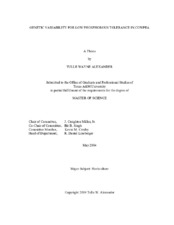| dc.description.abstract | As a result of rising fertilizer prices and environmental concerns, efforts are being made to develop crop varieties with better nutrient acquisition and use efficiencies to ensure higher yields and sustainability, especially in the semi-arid tropics and sub-tropics where soils are inherently low in nitrogen and phosphorus. Cowpea does not require additional nitrogen fertilizer because of its ability to biologically fix nitrogen, but it needs phosphate application. However, preliminary studies have shown that some cowpea genotypes have the ability to extract bound phosphorus from low-P soils and from rock phosphate.
Therefore, a project was initiated at Texas A&M University to develop high yielding cowpea varieties with enhanced acquisition and efficient utilization of phosphorus from low-P soils and rock-P. This study was conducted to screen 12 selected cowpea varieties under low-P soil, with rock- phosphate application. One-kg pots were filled with 1000 g of low-P soil (< 4 ppm) collected from Nacogdoches, TX, and amended with five phosphorus treatments – no added phosphorus, 200, 400, and 600 ppm rock-phosphate and Normal-P (Hoagland’s solution). Pots with No-P and rock-phosphate treatments were treated with a modified (P-free) Hoagland’s solution. The Normal-P treatment received unmodified Hoagland’s solution. Pots were arranged in a completely randomized design with three replications and planted with three seeds which were thinned to a single plant per pot after emergence. Pots were watered every second day to field capacity with reverse-osmosis purified water. The experiment was terminated 42 days after planting and dry weights of plants from each pot were recorded.
Major varietal differences were observed for biomass production in the low-P and rock-P treatments. Some of the promising cowpea varieties are IT97K-1069-6, IT98K-476-8, TX 2028-1-3-1 and Big John which performed well regardless of phosphorus treatment. California Blackeye #50, Dan Ila, IAR-48, and IT00K-1148 performed poorly in low-P soils, but exhibited significant growth response with addition of rock-P. | en |


